Services

Green energy
What we do
The range of services offered by bioconstruct is unique. There’s no other company that offers a full suite of planning, construction and operation services for solar, wind energy and biogas projects, all under the one roof. We’re your one-stop shop for comprehensive solutions for the most-important sectors of the renewable-energies business. And with over 20 years of experience on top of that, too.
Biogas
Questions and answers about our services
Why is biogas important?
Renewable energies are continuously gaining importance. An increasing number of countries alongside Germany are turning towards sustainable fuel, energy and heat generation using biomass. Many countries are supporting the expansion and use of renewable energy by passing corresponding laws such include funding and subsidies for the construction and operation of biogas plants.
How does a biogas plant actually work?
Biogas is created by fermentation of organic substances. In nature, this fermentation can happen at the bottom of bodies of water or in bogs, for example, or even in the stomachs of ‘ruminant’ animals (e.g. cattle or sheep). At a biogas plant, the controlled fermentation process takes place in fermentation tanks known as ‘digesters’. These large tanks contain the organic substrate, which is decomposed by methane bacteria. This process, called anaerobic digestion, produces a mixture of gases. Roughly 55% of it is methane, an energy-rich biogas. The digestate, that is left over after digestion, can also be fully reused as a natural, nutrient-rich fertiliser.
There are four stages during the biogas formation process. During hydrolysis or the liquefaction stage, the starting materials (fats, carbohydrates and proteins) are split into their fundamental chemical elements (such as fatty acids, monosaccharides and amino acids). During acidogenesis or the acidification stage, the hydrolysed materials are broken down into organic acids. The third stage, acetogenesis or acetic-acid production, sees the microorganisms transform these materials into hydrogen, carbon and acetic acid, the precursor materials to biogas.
Methanogenesis, or methane production, forms the final stage of the process. Without oxygen( ‘anaerobic’ conditions), the methane bacteria first turn the acetic acid into carbon dioxide, hydrogen and methane. The carbon dioxide and hydrogen subsequently become water and methane. Then, before further use, the biogas is desulphurised, purified and upgraded to the relevant plant demands. If you’d like to find out more about modern biogas plant construction and biogas technology, then we would be delighted to explain the details to you in a comprehensive information and consultation session.
Why do biogas plants use so much maize?
In Germany, roughly 900,000 hectares of maize is farmed for biogas plants, which is about equivalent to the amount of land used for maize farming in the late 1980s. Maize grows to be very tall right before it is harvested. It’s difficult to oversee and hence is seen as something “quite dominant”, though its size also offers a benefit: maize produces more biomass per hectare than almost any other crop. What’s more, it requires little water and fertiliser, and yet still forms a great amount of gas during fermentation. The farming of bioenergy crops has also had a significant part in stabilising incomes in the agricultural sector. Farmers benefit from higher profits when they sell their harvest, while biogas plants offer many farmers a secure foundation for generating income in times when milk and meat prices are low. (Source: Fachverband Biogas e.V.)
How much biogas can be produced on average?
The electrical output of a biogas plant ranges from roughly 75 kW (a small plant) to several megawatts (a large plant). The amount of power that a plant generates depends on the amount of biogas produced. A farmer can expect to obtain 400 to 500 m³ of biogas per livestock unit per year. One hectare of pasture grass can produce up to 7,000 m³ of biogas per year and energy-rich plants such as turnips or maize can produce even more. This means that building a biogas plant not only profits the climate and environmental protection, but is also a sustainable investment in a farm’s future viability and profitability.
How are plants planned, approved and financed?
Producing biogas requires a permit. If you wish to operate a biogas plant, you need to be familiar with the legal requirements and complete all the necessary formalities before starting construction. We’re happy to support our clients with their applications for permits. We can boast over 20 years of knowledge from applying and developing these systems, so we’re closely familiar with the individual steps and processes. We clear a path through the administration & government jungle of forms so that your biogas plant is fully compliant with applicable law and you can take full advantage of all potential funding and subsidies granted by the state and the nation.
Once the preparations are complete, you can get started building your biogas plant at your intended location. We perform all the required inspections and professional acceptance testing before putting it into routine operation. If desired, we can also make a separate arrangement to guarantee a specific electricity, gas or heat yield from your plant, giving you full certainty for your planning and finances.
Which biogas plant suits my needs?
Using our modern process control system, BioControl, we ensure that biogas plants always perform at their best potential and at an optimal profitability. The software was developed by experienced bioconstruct technology specialists and can also be retrofitted to older biogas plants. It can help you to configure your plant perfectly to your needs (e.g. for an on-demand-based electricity generation) and enjoy a precise overview of individual operational processes at all times.
How do you turn manure into fuel for lorries or carbon dioxide for soft drink?
Unfortunately, animal waste and slurry can’t be put straight into vehicle fuel tanks (just yet). Nevertheless, there’s an alternative that’s just as genius: our biogas plants digest slurry and manure and produce biogas from them. The main products created from this are carbon dioxide and methane. These two are separated from each other and purified using biogas upgrading systems. The carbon dioxide is then purified again and compressed. The end product is ready to dispense into bottles and be transported to soft drink bottling lines to carbonate beverages. Alternatively, it’s also possible to make dry ice – which is already done at our Crofthead biogas plant (see our testimonials).
The methane embarks on an even-longer journey. It’s usually fed into the gas network at the same location as the biogas plant. Then, at any other point in the gas network, an equivalent amount is extracted back out of the network and conveyed to a liquefaction facility that turns the biomethane into bio-LNG (liquefied natural gas). Heavy goods vehicles can use this as fuel and drive up to 1,000 km per tank of it (compared to roughly 1,500 km on diesel), making it an excellent alternative to diesel. The best part is that both the carbon dioxide and LNG can be produced in an environmentally friendly way, while generating and marketing them together with CO2 certificates provides for great profits. This creates a perfect synergy between economy and environment.
What does bioconstruct offer?
bioconstruct plans, builds and maintains plants for farms, medium-sized plants for community use and waste-to-energy plants for industrial use. We have the right technical solution ready for any type of input material or we can create a solution together with our partners. When it comes to utilising biogas, we offer cogeneration and ORC plants as well as biomethane upgrading plants and technology for further processing of the gas. Accordingly, we can generate valuable fuels such as CNG or LNG out of biomethane and even make good use of the carbon dioxide from biogas.
#this_is_how_biogas_works
Certainty for planning
We know from experience how things go
Based on the experience we’ve gained from many biogas projects we’ve developed ourselves, we possess the entire toolkit needed for successful project development: knowledge of agriculture, state-of-the-art planning software, precise contract templates, a sound knowledge of commercial law, excellent contacts with banking and financing partners and, last but not least, best-practice experience in relation to plant operation. With us you can be assured of having partnered with someone being able to provide you “everything” from one single source at an affordable price, from the greenfield site ultimately to a complete project.
Investments
Long-lasting security for everyone’s capital
bioconstruct operates over 20 biogas plants either alone, in conjunction with agribusinesses or with its known investors, friends & family. Overall an investment of more than €80 million has been realized by such partnership schemes which allows everyone involved to play out their strengths and thus creating advantages for all involved. If you have a fantastic project but lack capital, we’d be happy to join as a (co-)investor subject to a positive project check.
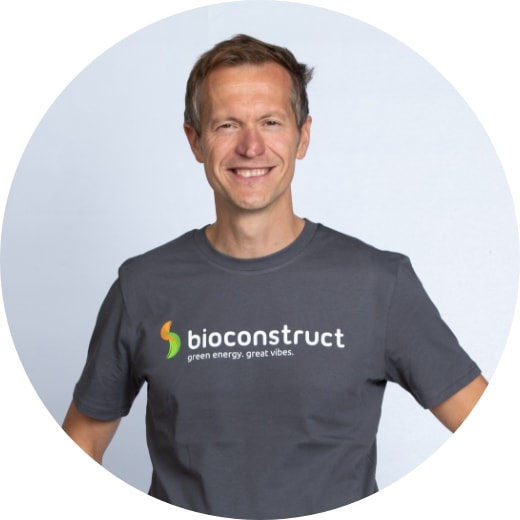
Secure your
new biogas plant
in 3 steps
Engineering and
technical planning.
Permit approved.
Check!
#plan_of_action
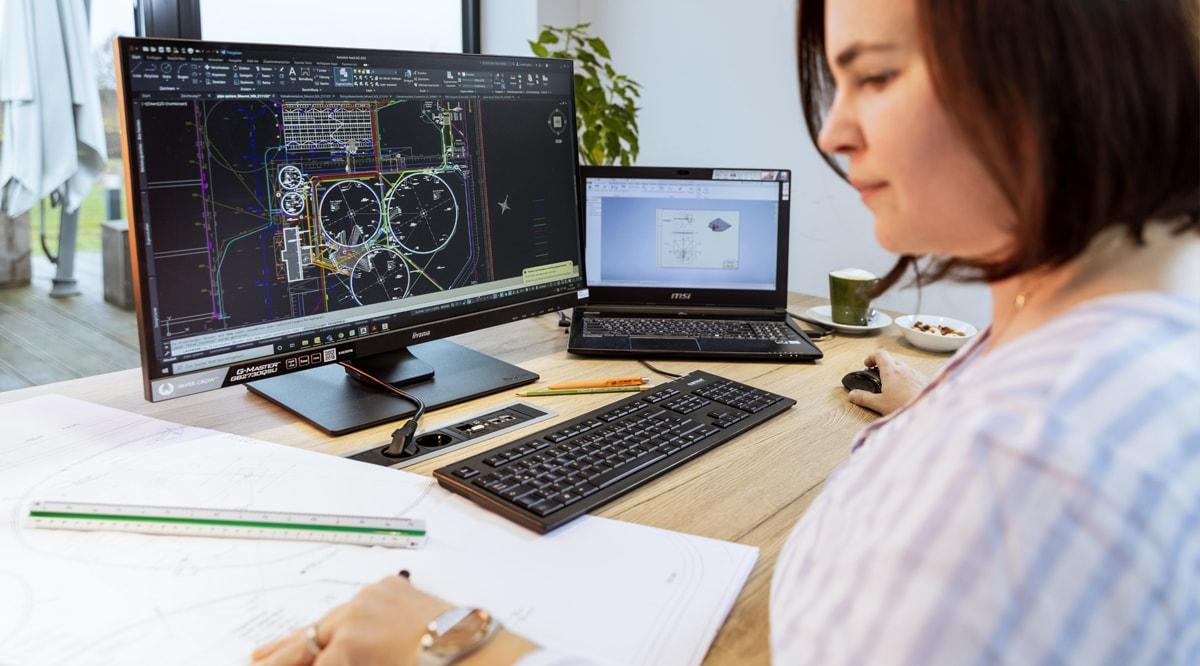
1. Project planning
bioconstruct has a design and engineering department with an excellent team of experts in construction, process engineering, heating technology, gas technology, electrotechnology and more. To ensure the optimal preparation for the subsequent construction, any key component of your biogas plant is planned and designed individually by our planners and engineers beforehand. 3D models can be created for the pipework and -brackets to ensure a good space utilisation and production. If requested, we can act as a project designer and provide you with detailed engineering so that you can build your plant with any third party.
2. Permit planning
We’re alongside yourself as a partner for the preliminary planning of your project and put together the permit applications needed for your plant. We accompany your project from the filing of the applications until the final approval. In addition, we create the operational documentation that you’ll need, for example explosion safety documents, incident response plans, alarm plans and plant documentation. We’ve gathered more than 20 years’ experience in these fields, which means that we can give your project the ideal support with the necessary planning skills.
3. Permit check
There have been quite a few court cases in Germany that show what can happen if a plant is operated outside its permit. Non-compliant operations of a plant may be deemed an offence and attract a fine, which in turn can result in having to repay all illegally earned revenue (not just profit!). With our permit check service, we study your permit documents and check these against your on-site documentation or your on-site plant operations. If we detect shortcomings, we compile a catalogue of measures for remedying those and, if necessary, we recommend additional services or name relevant experts that may be needed. As a result, you’ll be optimally prepared for inspections and audits by government offices or authorities.
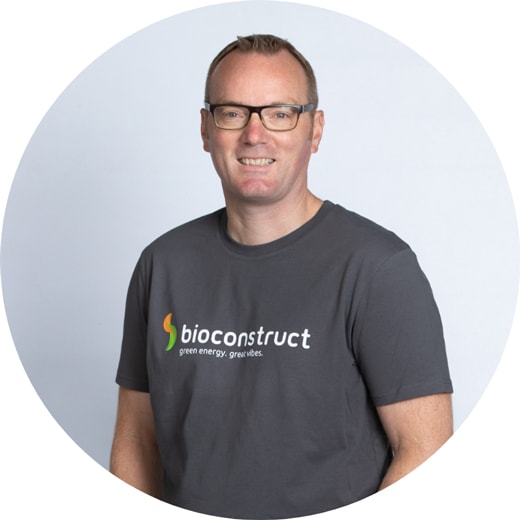
#controllin’rollin’rollin’
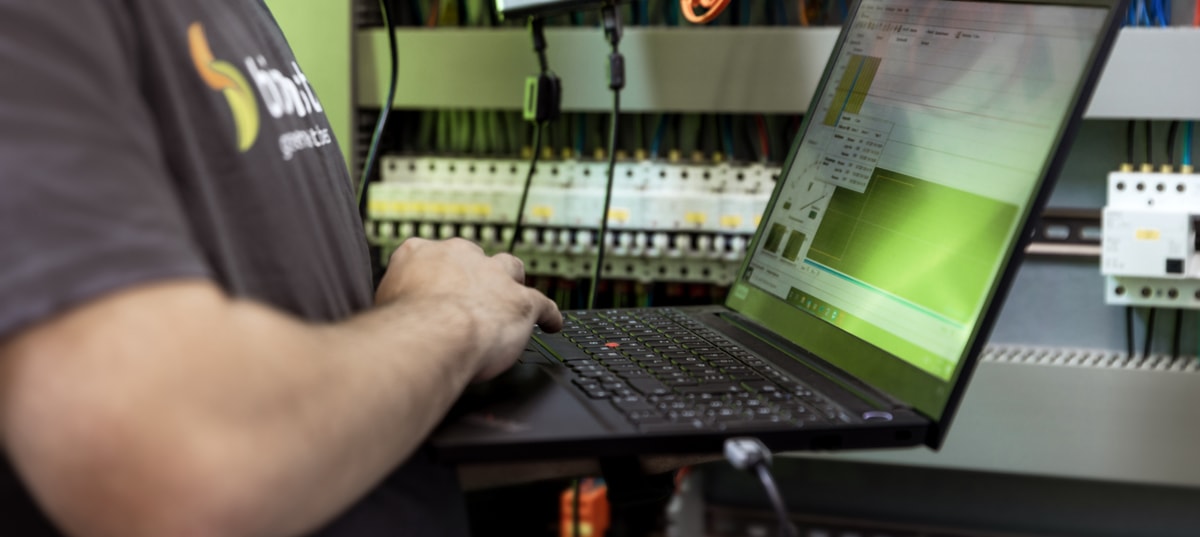
Everything under biocontrol …
Software and hardware
for optimal plant operations
BioControl is the name of our own developed software which our tech team keeps continuously up to date and evolving. It’s an application that provides what a plant operator is looking for, such as electrical load management, on-demand power generation, dashboard system monitoring, plant documentation, daily management reports and much more. BioControl 2.0 offers you a process visualisation based on the latest technology on the market. It’s compatible with all types of controllers (e.g. Siemens S7), which means it can be easily retrofitted to existing plants.
We also develop some of the ‘hardware’ for biogas plants in-house. In our workshop we build special components such as the stainless-steel substrate heat exchangers or wall ducts. Moreover our engineers are continuously working to develop new systems for intelligent and demand-based gas storage.
We are a certified specialist for plants that are used to handle water-polluting substances in accordance with section 62 of the German Water Resources Act (Wasserhaushaltsgesetz). Consequently, we are authorised to construct biogas plants, empty & clean them, maintain them and ultimately to take them out of service. More information about this certification please click here (in German).
Turnkey projects
Fully wrapped biogas plants
All in one hand without any cost or interface risks – we’re an experienced technology provider and general contractor who can be your partner and deliver the entire plant, commencing with excavation and infrastructure works and finishing with a successful plant test run, and even with a guaranteed gas yield if desired. We’ve delivered over 300 turnkey projects – with single project contract volumes of more than €25 million net- only bioconstruct can offer you this level of experience!
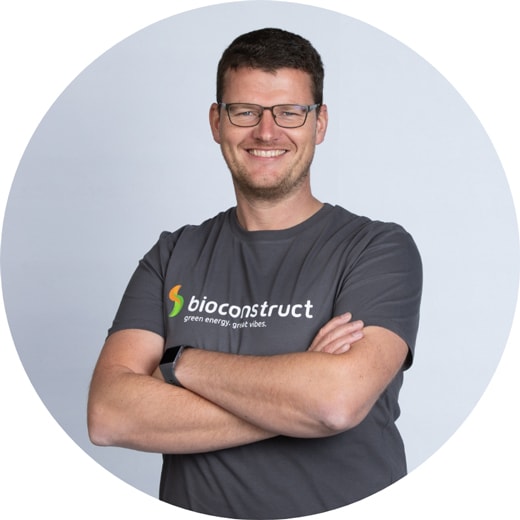
Keeping your biogas “tip-top”
Our service and maintenance offering
Spare parts
We can achieve excellent prices for you due to the economies of scale. Thanks to our stock in our own warehouse we have access to critical components which we can provide quickly in case of an emergency.
Simone Kleine-Börger
Service Back Office
service@bioconstruct.de
Overhaul and renewal
Biogas plants are exposed to extreme wear and tear during daily operation. In particular, the interior of the digesters and digestate storage tanks face a heavy burden from abrasion, corrosion from sulphuric acid and temperature variations between the inside and outside. These factors can make even the best of liners fail and corrode the concrete. Normally, every tank must be inspected, emptied and relined inside at least once during its 20-year service life. We’re happy to help you and procure the entire overhaul – quickly and efficiently so to keep production losses to a minimum.
Dirk Hohage
Project Manager Service
service@bioconstruct.de
Plant inspections & audits
Biogas plants are subject to highest safety standards, which is why they are fitted with numerous sensors, shut-down features, automatic valves and measurement features. These must be regularly checked by a certified expert. In Germany, for example, such checks are to be conducted every three years. We can do this and provide recommendations for optimisation so that your plant always gets the best results in class by the authorities.
Further on we can offer you thermal-imaging inspections of your electrical cabinets, German DGUV A3 inspections, and -last but not least- leak detection for your gas roofs.
Axel Emrich
Head of Service
service@bioconstruct.de
CHP service & maintenance
Services for your biogas plant, all under one roof: with us, you have a partner who not only takes care of all components necessary for gas production, but also of the things which utilise your gas. Our technicians can perform maintenance on your combined heat and power plant (CHP) no matter what manufacturer it’s from. Simply enquire with us about it.
Patrick Baller
Project Manager Service
service@bioconstruct.de
Commercial & technical management
We’ll name a few keywords to start with: electricity tax discounts, declarations of conformity, Parasitic load, Medium Voltage Directive and environmental expertise. The increasing complexity of laws and regulations is raising the demands of managing and operating a biogas plant, in particular the commercial aspect. We rely on our experience of over 15 years in plant operations to manage more than 20 projects in Germany and abroad.
We provide the on-site operations personnel and manage the commercial affairs of the operating company. We’d be delighted to offer you our services.
Henrik Borgmeyer
Managing Partner
h.borgmeyer@bioconstruct.de
24-hour emergency service
Have you heard of Murphy’s Law? When things go wrong, it’s always on a Friday evening or public holiday. With bioconstruct, though, that’s not a problem. We’re at your service at any time of the day or night throughout the entire year, with staff who are highly competent at what they do (usually with an electrical background). If we’re unable to sort out your issue through telephone support or remote maintenance, we’ll immediately organise an on-site intervention to fix the fault.
24-hour service & repairs line:
+49 5226 860 999 7
Repowering
Repowering often is more worthwhile than people actually think. In the near future, refurbishing your plant to a fuel-producing biomethane gas to grid plant might be a very lucrative option for you. We are happy to evaluate this possibility for yourself and deliver you a turnkey gas upgrading plant.
There has also been significant progress in the solid feeding technology. For example, difficult input materials such as domestic waste or manure can nowadays be fed into the plants at a much lower level of impurities and with way less electrical power. Further on, installing our BioControl with the electrical load management can reduce your plant’s power costs by avoiding peak loads.
These are just a few examples of potential optimisations for your plant. There’s no reason to hesitate – simply get in touch with us today.
Martin Aumüller
Sales
service@bioconstruct.de
Wind energy
Questions and answers about our services
Why do wind turbines stand idle despite the wind blowing?
People often assume that a wind turbine stands idle because the turbine has been erected at a place where there is not sufficient wind. In reality, though, there are a variety of reasons why wind turbines do temporarily stand still. As the name of the technology suggests, wind turbines by their nature depend on wind. Measurements of the local wind conditions ensure that wind turbines are built in the right places so when the blades stop turning, it is mostly due to other reasons.
The two most-significant obstacles for a more-efficient use of the wind energy are the delayed power grid development in Germany and an oversupply of conventional electricity. Occasionally, wind turbines need to be shut down at times when they could theoretically be working at their peak efficiency, for example when strong winds feed a lot of power into the power grid. This will happen on fewer occasions in the future due to two reasons. First: an optimised, high-performance power grid will be capable to absorb more wind power and establish a better balance between supply and demand. The rapid expansion of the grids will ensure that renewable energies have the largest proportion in Europe’s long-term energy mix. Second: If we’re to take climate protection seriously, coal and lignite power plants must be shut down consistently over the next few years. They have little flexibility which results them blocking the power grids with climate harming power – and that clogging leads to the shut-down of flexible wind turbines. In the power system of the future, which will be reliant on wind energy, other renewables and flexible gas power plants, there will be no longer the need for coal-fired power plants.
In addition to the above, there are a number of additional reasons why wind turbines stand still despite good winds. Maintenance and repairs as well as the protection of birds and bats during breeding season or other activity times. Turbines are also temporally shut down to protect local residents if the sun is low and the turbines cast a shadow on neighbouring houses for longer than 30 minutes a day. (Source: Bundesverband WindEnergie e.V., 2021)
Can wind turbines be recycled?
Wind turbines are demanding high-tech components. Despite that, dismantling them and recycling their components has now become a routine matter, as companies in the waste industry can confirm. There are companies that offer straightforward solutions for a cost efficient recycling of wind turbines.
Modern wind turbines are almost fully reused, with 80 to 90 per cent of the components in terms of its weight being recyclable. This is due steel and concrete making up over 80 per cent of a wind turbine. The concrete parts of the foundation can be processed and be used as recycled concrete for new roads. The steel segments are returned to the steelwork factories as a secondary material. Recycling the rotor blades is probably the most-difficult part due to their composition out of fibreglass, carbon fibres and other plastics. If they can’t find another life cycle in a secondary market – usually outside of Europe – they are incinerated by specialised companies and processed for use as a secondary material.
The incineration process involves the rotor blades being crushed, metal parts such as lightning arresters being removed and the leftover product then being burned. The remaining ash, which is less than 30 per cent of the volume of the original material, can be used as a substitute for other raw materials in the cement industry. Processing 1,000 tonnes of fibreglass – the same type used in the automotive, shipping and aviation industries – in the manner just described above, can prevent the consumption of about 450 tonnes of coal, 200 tonnes of chalk and 200 tonnes of sand. This is overall a recognised process: Bremen-based company neocomp GmbH, for instance, recently received the GreenTech Award for this process.
The manufacturers of wind turbines have also set zero-emissions targets for themselves and are endeavouring for an European-wide circular economy. They are continuously investing in research projects and in the optimisation of production and recycling processes. The results are documented in publicly available sustainability reports. (Source: Bundesverband WindEnergie e.V., 2021)
Do wind turbines affect people’s health?
People are surrounded by modern technologies each and every day, not only in towns and cities, but also in their private households and working environments. However, wind energy is one of those technologies that have a highly visible presence in the landscape. This is why people who live nearby wind turbines ask – quite understandably – if wind turbines near residential areas have an impact on people’s health.
There are various studies and reports that debunk these fears. Studies by Germany’s Nature and Biodiversity Conservation Union and various state environment agencies prove that noise in the direct vicinity of wind turbines does not reach a level which is anywhere near concerning for people’s health. Just like choppy wind, surf from the ocean or passing cars, wind turbines also emit noise at very low frequencies, referred to as ‘infrasound’. This infrasound consists of very low tones with a frequency of less than 20 hertz (Hz). Humans cannot normally perceive such frequencies, though some neighbouring residents fear that they can be harmed by infrasound exposure.
Nevertheless, long-term studies show that only a small portion (5 per cent) of people who live in the direct vicinity of wind turbines report symptoms such as headache or sleep disruption. A long-term study by the VTT Technical Research Centre of Finland concluded by saying ‘No evidence of health effects of wind turbine infrasound was found’. To explain the allegedly frequent occurrence of symptoms nearby the wind turbines, the study suggested that they were the result of a ‘nocebo effect’ (analogous to a placebo effect), where influences that are not actually harmful to the human body end up having a negative effect on people’s health because these people think the influences have a negative effect. Symptoms caused by other things can also be incorrectly associated with wind turbines. The infrasound from wind turbines can be contrasted against the infrasound levels found in day-to-day situations, such as inside a saloon car driving at 130 km/h. Such level is much higher than those of a wind turbine 150 metres away. The studies are backed up by a judgement made by the Würzburg administrative court in a case regarding the harmlessness of noise emissions from wind turbines. (Source: Bundesverband WindEnergie e.V., 2021)
Why are wind turbines getting taller and taller?
Many wind energy projects attract criticism because the wind turbines are getting bigger and taller. Fifteen years ago, the maximum height of a turbine has been 100 metres. These days, they reach up to 250 metres. The simple fact is that there is more wind at greater heights, with the yield increasing by 1 per cent (approximately) for each additional metre that the hub rises. The higher yields from the wind turbines not only benefit their operator, but also helps to protect our nature and benefits our society as a whole. That’s because the operator can sell its power at significantly more-affordable prices thanks to the increased yields from its turbines, and that means the financial support needed for a wind turbine is reduced to a minimum. Furthermore, the higher yields allow the turbines to be shut down for longer periods to minimize affection of local residents by noise and shadow flicker. Wind turbines are even shut down during breeding seasons to protect sensitive bird species such as storks, buzzards and red kites, reducing the risk of collision significantly. These things wouldn’t be possible without the financial buffer provided by a tall wind turbine.
How much power can a wind turbine deliver?
Today’s wind turbines feature a direct connection to the power grid; the electrical energy produced is transferred and fed onwards using power electronics. The peak power of a contemporary onshore wind turbine averages between 3 to 6 megawatts. Offshore turbines are significantly bigger at 6 to 10 megawatts, however these plants are way more expensive to build.
How economical is wind energy in comparison?
Wind turbines are a catalyst for the energy revolution, with many countries supporting their construction and operation through feed-in tariffs and legally mandated targets for wind energy development. The electricity generation costs are an important factor when comparing solar photovoltaic systems, biogas plants and wind turbines. These costs include all the expenses for generating power from the renewable source of energy, for example the costs to build a system and operate it. Put in context with the power produced by the system, the electricity generation costs say a lot about a system’s cost-effectiveness.
The latest studies show that renewable energies have become competitive. A new solar system or wind turbine, positioned at the right location and backed with a carefully planned financing concept, will already operate more economically today than a new power station fired by fossil fuels- without harming the environment!
What does bioconstruct offer?
When it comes to wind turbines, our focus is on project development, planning, providing the infrastructure (cabling, earthworks and foundations) and financing. We’ll be at your side for the entire journey, from the initial idea and getting permits and funding to managing the wind turbine’s profitable operation. We’ll answer your questions about the opportunities of a given site, for financial support and feasability assessments. We’ll help you to develop a profitable new wind energy project as well as to optimise existing turbines and wind farms. When you come to us, you can rest assured that we’ll remain your point of contact even after construction is finished. For instance, we still administer the very first community-owned wind farm we built back in 2001- with over 150 satisfied invested locals.
Get in touch with us to on-board a team of dedicated experts for your project development and transform your idea and planning into a successful and sustainable result. We’d be happy to set up a phone call or personal meeting so we can explain to you all the details surrounding site analysis, turbine construction, engineering and modern wind power financing.
Networking for wind
A strong network for successful wind power projects
Since it was founded in 2001, bioconstruct has worked on the construction of plants and turbines and on supervising projects for the use of renewable energies. The first bioconstruct wind energy projects were completed in 2001. Since then, we have earned lots of experience, , have continuously expanded it and kept it up to date. bioconstruct has planned, built and successfully commissioned more than 55 wind turbines in six of Germany’s states. Moreover, bioconstruct is involved in a network of companies which have completed wind energy projects worth over €500 million around the world.
Investments
Public involvement and security for everyone’s capital
We have a considerable financial stake in every project that we develop. We’ve already invested €12 million of equity in our projects and used that to attract a total investment amount of over €100 million. We believe it’s important to get all project stakeholders involved and not just invest by ourselves. In our wind energy projects, for example, it’s not only the property owners who gain a stake.The local residents get involved as well. Back in 2001, we launched our first community-owned energy project, called Region Regenerativ Melle – Energie aus der Heimat (‘Melle Renewable Region – Energy from the Community’). We are proud to still manage this investment today.

Up to an
operating wind turbine
in 3 steps
Planning. Permit. Construction.
Operation. Check!
#check
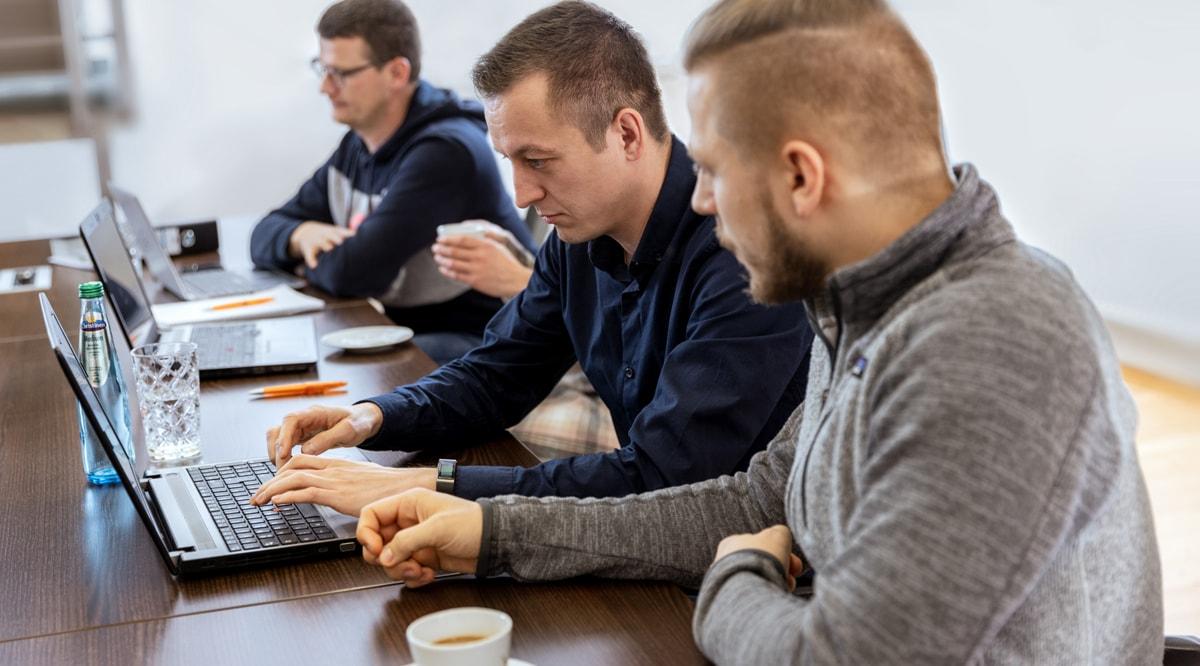
1. Project planning
For us, a wind energy project starts with a ‘greenfield site’. By performing white–region analyses we find suitable locations, or we develop in special areas zoned for wind energy development. We offer fair models for the property owners involved and allow them a (financial) participation in the projects . Following this first step, we take care of all infrastructure provisions such as roads, power connections or building a substation. In particular, we make sure to include the relevant local authority in the planning process as soon as possible as a wind turbine can potentially upset the local natural environment. These constraints and upsets must be dealt with properly and correctly if we are to succeed with the renewable energies. Do you have a suitable site? Get in touch with us and we’ll turn it into something great!
2. Technical planning, approval and legal assessment
At this point of time, getting a permit for a wind energy project is one of the most-complex things you can do in our industry. There’s a broad variety of laws and regulations that must be followed and applications are increasingly being cross-examined in courtrooms. Applications can often take several years to be approved. Our permit planners have over 10 years of experience and work together with well-known experts to compile the documents needed, from a geotechnical report to the environmental-impact assessment and legal access rights. The process concludes with a full legal assessment, which means your project is in good hands with us.
3. Ongoing commercial and technical management
In conjunction with EFG Energy-Farming GmbH, our partner company from the neighbouring town of Bad Essen, we cover the entire spectrum of managing wind turbine operations. Our managerial services range from organising and monitoring all maintenance jobs to assessing insurance claims and accounting and annual reporting. We keep track of turbines and finances while being in permanent contact with all involved business partners.

Turnkey projects
All services under one roof
Constructing a wind farm takes more than just erecting a few wind turbines. Wind turbines are usually delivered by the manufacturer in pieces and then need to be fully assembled in sitiu. That assembly also includes setting up almost 250 metres high cranes which require more than 25 truckloads of individual parts. Extensive preparational works need to be performed before such a complicated master piece with regards to logistics and construction can actually take place. It involves building roads, setting up storage areas, installing cables and constructing deep and shallow foundations. We offer all these services under the one roof and can act as a single point of contact for investors.
Solar energy
Questions and answers about our services
Why is solar energy important?
The sun is the planet’s most-important source of energy. This gigantic, natural power plant at the centre of our solar system will remain available to us for billions of years to come. Photovoltaic systems use exactly this source to generate electricity, so raw-material shortages won’t be an issue– even in the long run.
Do photovoltaic systems reduce the amount of available agricultural area?
When solar photovoltaic systems are built in open spaces, it’s usually in such areas that are designated as ‘unfavourable’ land. Unfavourable might be, for example, low-yield areas with poor soil or not enough rain. Even in good spaces, system owners might build ‘agrivoltaic’ systems, which consist of panels in a vertical angle that allows farmers to continue using the land , e.g. as a pasture. More details on this can be found on the website of our partner, Next2Sun GmbH.
What is the future potential of photovoltaic ?
Photovoltaics (PV) , is planned to become a key pillar of the energy revolution. It offers massive potential, and not only because with rooftops and open areas huge amounts of space are suitable for solar PV systems. The main argument to make even more use of solar photovoltaics is that this technology has become enormously more cost-effective.
Can solar photovoltaic systems in open spaces be integrated in a nature friendly manner?
Yes, they can! Flowering plants and herbs can be grown between panels to provide an ideal habitat for bees and other insects. At some of our photovoltaic sites, there are even sheep that graze in these spaces. The animals are happy and content to graze beneath the panels when it’s windy or hot outside, which has a pleasant side effect of stopping the vegetation around the system from growing too tall.
How much do solar photovoltaic panels cost?
The prices for solar PV panels decreased by 90 per cent (!) between 2010 and 2021. The nowadays attractive investment costs, coupled with relatively low operating and maintenance costs, have resulted in solar power being able to be generated for less than €0.05 per kWh. This is cheaper than any conventional power plant if you consider carbon emissions in your calculations.
For this reason, we’re expecting a solar-power boom over the next decade. Not only in sunbathed areas such as southern Europe, but also and especially in places that consume lots of electricity, like densely populated Germany for example.
Is solar photovoltaics more efficient than biogas?
Farmers and community representatives often ask if it would be better to use a hectare of farmland to install a solar photovoltaic system rather than growing plants like maize for biogas. There’s good reason to ask this, as a solar PV system produces 32 times as much power per hectare compared to biogas. However, such a figure is only half of the truth. In addition to power, biogas plants produce an equal amount of heat. Accordingly, the energy yield from a solar PV system is only 16 times greater than biogas. This is still a very large yield and would make you think that solar power is much better than biogas. Yet for as long as there isn’t an affordable method for storing solar PV power, we need to use the electricity from solar PV systems at the time it’s produced, which is usually around midday during summer. Biogas power, on the other hand, is always available and can even be generated on a demand-based basis, i.e. whenever supply is running low and there are clouds in the sky (or at night). This is what makes biogas power so valuable and suggests that the two forms of energy are equally important. The power from PV is cheap but not reliable, whereas the power from biogas is reliable and therefore extremely valuable!
What does bioconstruct offer?
bioconstruct concentrates on planning, constructing and overseeing large systems on commercial rooftops and open, non-built-up areas. The ideal open spaces are meadows and fields beside motorways and railway tracks as well as farming areas that have low yields when used for food or feed production. Unused industrial estates and former airports are also ideal for conversion.
#KnowledgeAdvantage

Forecast: boom!
Solar power is a hot investment
Solar photovoltaics is a popular, entry-level solution for renewable energies. Why? The prices have dropped by 90% in recent years. The affordable investment costs are complemented by relatively low operating and maintenance costs, with solar photovoltaic energy able to be produced for less than €0.05 per kWh. For this reason, we’re expecting solar photovoltaics to boom very soon, both in sunbathed areas such as southern Europe as well as in places that consume lots of electricity, like densely populated Germany for example.
Investments
Public involvement and security for everyone’s capital
Over the last 15 years, the bioconstruct Group has set in motion over €120 million for renewable-energy systems thanks to the dedicated funding it has sourced. Our core duties are structuring financing and attracting loans and equity needed for it. We have contributed ourselves approximately 30 per cent of the equity required for our projects, giving us a long-term involvement tothem. This creates trust and confidence from our partners. After all, the best construction company of plantsis the2 one that invests in its technology itself!

Your own
solar photovoltaic system
in 3 steps
Planning. Permit approved.
Operation. Check!
#sunvibes
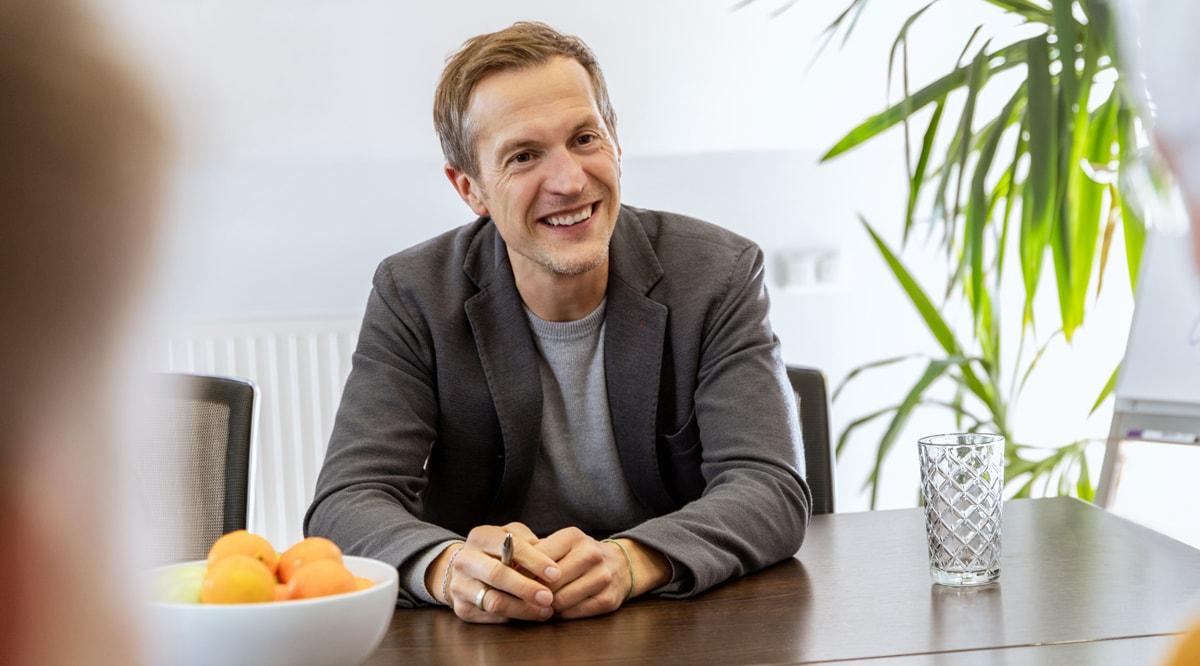
1. Project planning
We develop the concept for solar photovoltaic systems independently, from the initial conversations with the local authority and property owners, until the systems are ready for construction. We help choose sites, perform feasibility studiesand take care of the integration into the power grid. If the power grid at a chosen location isn’t capable enough, it might also be worth utilising the power on site by signing a power purchase agreement (PPA) with local industry businesses. This makes you fully independent of any subsidies. If you were to choose an option like this, there’s also the prospect of large-scale battery storage in the medium term, which would allow the power-consuming businesses to receive solar energy at night, too.
2. Technical planning and approval
Our employees’ broad knowledge provides the best foundation for engineering solar photovoltaic systems. We’ll be at your service during every stage of the project’s construction, be that in the drafting stage, when putting together permit applications, in detailed design or when putting it out to tender. We possess the software needed to design the orientation, angle and positioning of the systems in an optimal way.
3. Commercial and technical management
Fortunately, solar photovoltaic systems have very low maintenance needs . Their panels rarely need to be exchanged or repaired. Nevertheless, there are still a few things that need to be coordinated and considered. Those things include clearing vegetation, assessing the communications technology, maintaining the transformers, analysing performance, proof reading power bills and more. On top of that, there’s also the traditional business administration work that an operating company has to perform. We take care of everything so that you, the operator, can enjoy the sun!

Turnkey projects
All services under one roof
One of our lead engineers says, ‘If you can do biogas, you’re definitely able to do solar PV.’ And he’s not wrong. A solar PV system is significantly less complex, making it much faster to install. Nonetheless, there are still a few interfaces to watch out for and the construction companies need to be coordinated. We bundle together all the services to deliver you a turnkey system from under the one roof.
